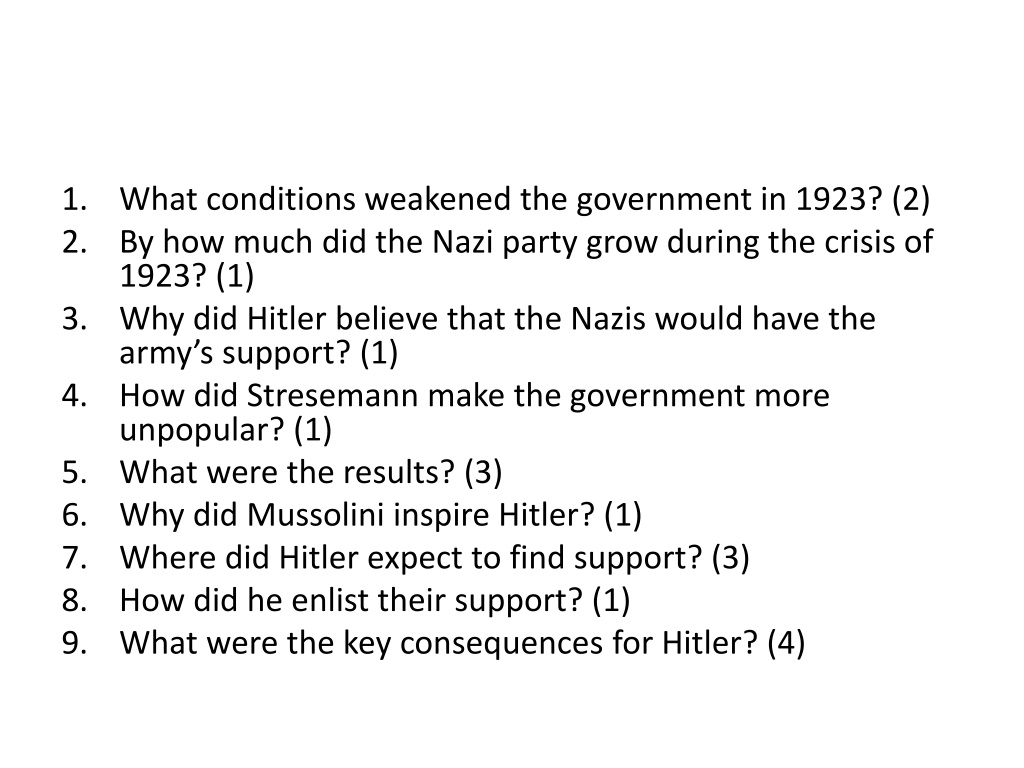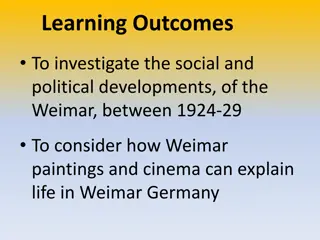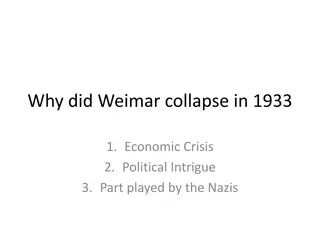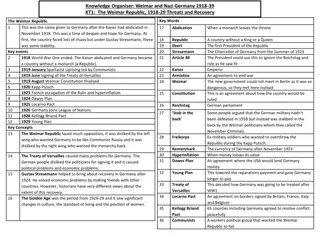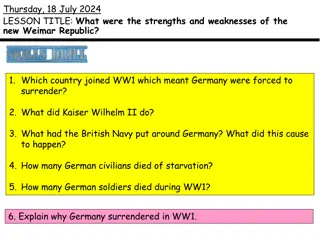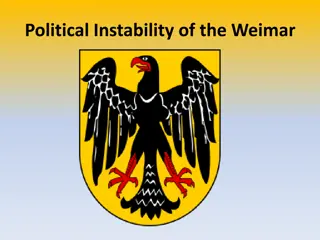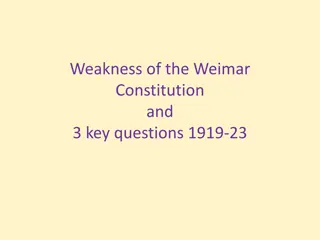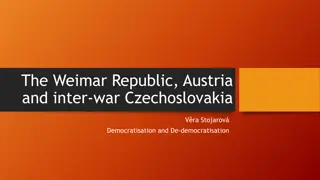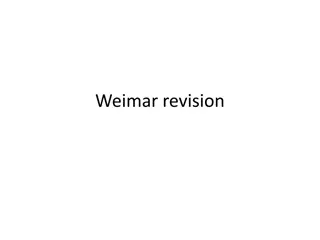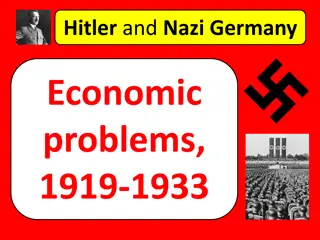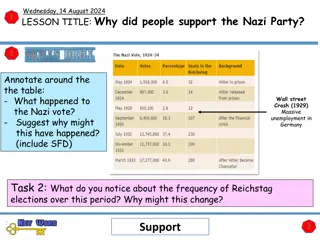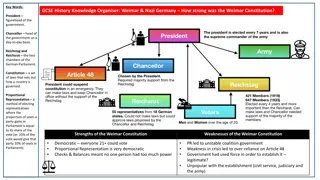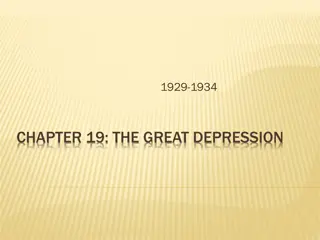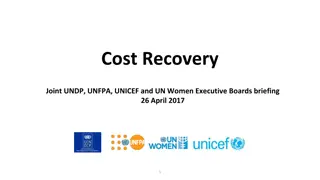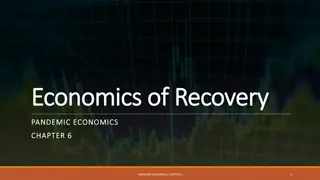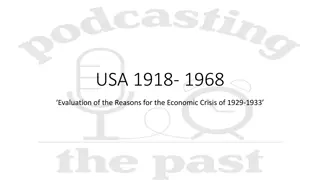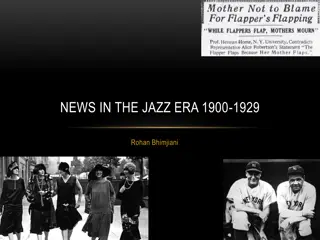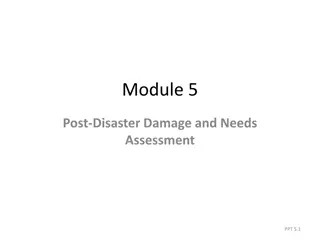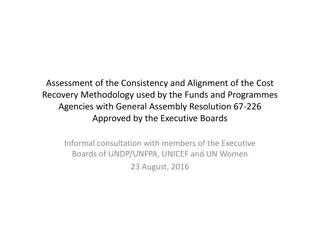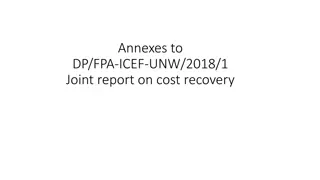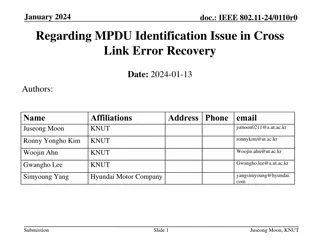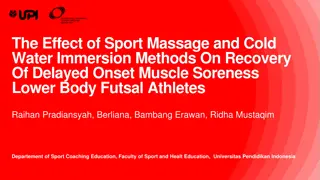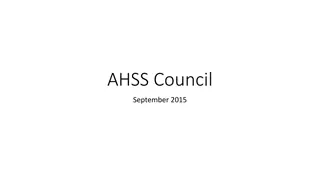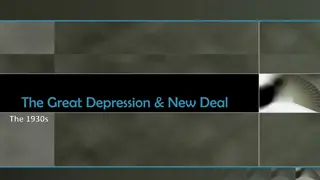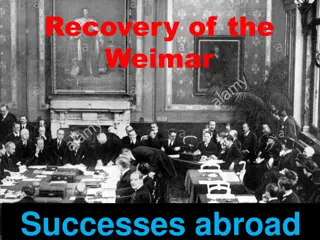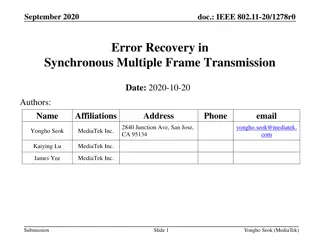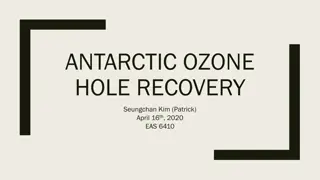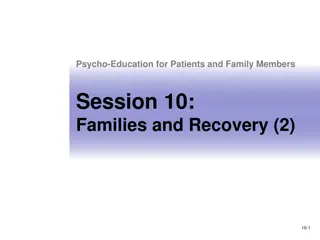Evaluating Weimar Germany's Recovery Period 1924-1929
The period of Weimar Germany from 1924 to 1929 witnessed economic, diplomatic, and political recovery under the leadership of Stresemann. The strengths included growth in industries, resolution of the reparations issue, and improved working conditions. However, challenges such as budget deficits, declining agricultural prices, and dependence on foreign loans persisted. Stresemann's foreign policy had some successes, like diplomatic normalization. The presentation aims to assess these aspects comprehensively.
Download Presentation

Please find below an Image/Link to download the presentation.
The content on the website is provided AS IS for your information and personal use only. It may not be sold, licensed, or shared on other websites without obtaining consent from the author. Download presentation by click this link. If you encounter any issues during the download, it is possible that the publisher has removed the file from their server.
E N D
Presentation Transcript
1. What conditions weakened the government in 1923? (2) 2. By how much did the Nazi party grow during the crisis of 1923? (1) 3. Why did Hitler believe that the Nazis would have the army s support? (1) 4. How did Stresemann make the government more unpopular? (1) 5. What were the results? (3) 6. Why did Mussolini inspire Hitler? (1) 7. Where did Hitler expect to find support? (3) 8. How did he enlist their support? (1) 9. What were the key consequences for Hitler? (4)
Weimar 1924-1929 Assess the strengths and weaknesses of Weimar s economic, diplomatic and political recovery. Were the Weimar years 1924-1929 really golden ?
Key things we need to know The Stresemann era. Economic Recovery? The Rentenmark, Dawes and Young Plans and the recovery of the German economy; reliance on US loans and investement Diplomatic normalization? League of Nations, Locarno Treaties and Kellogg-Briand Pact. Political Recovery? The role of Stresemann, the election of Hindenburg, the 1928 election Weimar Germany s Golden Years? Weimar Culture, the rise of Berlin, opposition to Weimar decadence
Use your textbook and the hand out to prepare a presentation to: Evaluate the strengths and weaknesses of the economic recovery; Evaluate the strengths and weaknesses of Stresemann s foreign policy (diplomacy); Evaluate the strengths and weaknesses of the political recovery.
Economics Strengths 5 Strengths GRIP W.C. Growth in some industries (especially Car and Cinema) Reparations problem organised on more reasonable level (Dawes and Young Plan: more money coming in than going out). Inflation problem cured in 1924 never to return. Production reached pre-1913 levels by 1928. Working Conditions wages rose every year between 1924 and 1929.
Economic Weaknesses 8 Weaknesses Bathfug W.C. Budget Deficit (spending exceeds income) Agricultural prices in decline by 1927 Trade Deficit (more imports than exports) High taxes (to pay for WC) Foreign Loans Germany dependent Unemployment (never lower than 1m) Growth is unsteady and uneven, plus German industry falling behind other countries. Welfare Costs are high.
Foreign Policy Success 6 Foreign Policy Successes: REBELLION ROAR Reparations re-negotiated (Dawes 1924 & Young 1929) Berlin Treaty, April 1926 (treaty of Rapallo 1922) allowed Stresemann to apply gentle pressure on west and to re-arm in secret. Locarno Pact (October) 1925 League of Nations (September 1926) 1. 2. 3. 4. Remove Occupation by Allies, 1924-5; 1929-30. Reduce allied supervision (supervision of German military by IAMCC) 1926. 5. 6.
Weaknesses of foreign policy In many ways, foreign policy was the most successful area of Weimar recovery in the years 1924 to 1929 but even here the government was heavily criticised by the extreme right: Policy of fulfilment seen as cowardly giving in to the western powers. Fulfilment meant fulfilling Versailles treaty so seen as a continuation of the stab in the back . It seemed to confirmed Germany s second-tier status The Treaty of Berlin in 1926 a neutrality pact with the soviet union was also hated, because it looked as if the country was being allied to communism (and therefore to Jews). Stresemann could not advertise the secret clauses in which Russia allowed Germany to re-build its Luftwaffe on Russian soil. It was also about keeping Soviet Russian neutral whilst Germany in anticipation of re-arranging Germany s eastern frontier.
Foreign Policy Weaknesses Stresemann s foreign policy was closely bound up with economic policy and in particular the Dawes and Young plans. Nazis hated the Dawes Plan because it was about fulfilling reparations payments. A Major campaign against the Young Plan defeated at Referendum, was called the Harzburg Front - but 5.8 million voted against the Young Plan. Funded by Alfred von Hugenburg, leader of the DNVP, but fronted by Hitler, the campaign raised Hitler to status of national politician; Criticism of the Young Plan before 1928 looked prophetic following the Wall Street Crash of October 1929. Provided the background to Nazi success after the Wall Street Crash. 1928 Poster Break the Dawes chains
Political Recovery 3 signs of Political recovery(APE) Assassinations and Coups no longer occurring Pro-democratic parties supported by the Majority of people (e.g. SPD, DDP, DVP). Extreme parties receive less support (Hindenburg s election perhaps shows more support for the Republic by the right).
Political Weaknesses 4 Political Weaknesses (Weak SPAR) The WEAKness of: The System - Proportional representation leads to fragmentation lots of small parties unable to form stable coalitions 6 governments 1924-29 only 3 created with election (25 governments altogether in the 14 years between 1919 and 1933); And of Parties internal divisions in SPD; big centre parties could not get along too focussed on self-interest Anti-Democratic forces within Weimar very strong (JACUB); Hindenburg s election worrying; Violence on streets between NSDAP and KPD. Reputation Republic founded in defeat; associated with Versailles
The key elements of Weimar Culture MADE MP 1. Modernism looks to the future rather than to the past - rejects tradition particularly rejects military values; admires technology, machines, speed, the city, all that represented the technological triumph over nature; (sometimes called New Objectivity stood in contrast to Expressionism). 2. Americanization and Night life - Berlin became the cultural centre of Europe and revealed the influence of American Mass Culture. 3. Democracy and Equality gender and race. 4. Expressionism expresses inner individual psychological experience or trauma (particularly resulting from war). 5. Marxism - critique of the capitalist system. 6. Promiscuity sexual permissiveness and experimentation.
Public Reaction and the Right Many Germans not just right wing groups - were horrified by what they saw as the collapse of traditional moral and cultural standards. Peter Purzer (Germany 1870-1945): To Most Germans the energy, the experimentation, the chaotic creativity which made Weimar culture the envy and Mecca of so many foreigners represented Kulturbolshewismus (Cultural Communism), the overturning of forms and values in a world in which too much had been overturned already. The predominant cry was in favour of a conservative revolution . Bodies such as the Kampfband fur Deutsche Kultur were created to campaign against nudism, homosexuality, birth control, Americanisation and feminism. Centre and right-wing parties blamed the lazy Un-German Weimar Republic for a de-generate culture that introduced tides of filth and cultural communism . The presence of Jews amidst the cultural experimentation (e.g. Kurt Weil) was seen by critics on the right as proof that Weimar Culture was un- German and that Jewish influence on German culture would lead to degeneracy.
The reaction of the public and the right Wilhelm Frick, who as Thuringian Interior Minister became the first Nazi in a state government in 1930, ordered modern art removed from museums and tried to restrict jazz performances. Bodies such as the Kampfband fur Deutsche Kultur were created to campaign against nudism, homosexuality, birth control, Americanisation and feminism. Centre and right-wing parties blamed the lazy Un-German Weimar Republic for a de-generate culture that introduced tides of filth and cultural communism . The presence of Jews amidst the cultural experimentation (e.g. Kurt Weil) was seen by critics on the right as proof that Weimar Culture was un-german and that Jewish influence on German culture would lead to degeneracy.
Homework It is 1929. You have been asked to write a confidential report for the Chancellor on the current health of the Weimar Republic. Write a confidential report for the Chancellor on the current health of the Weimar. Use the following three headings to explain how far Germany s situation has improved since 1924: Relations with other countries Politics The Economy Weimar Culture Which problems remain unsolved and which are the most serious?
